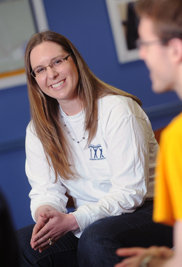Featured Article
Kent State East Liverpool’s Nursing Lab Receives $70,000 in Upgrades
Through a matching grant provided by the Ohio Mid-Eastern Governments Association (OMEGA), Kent State University at East Liverpool was able to make more than $70,000 in equipment upgrades to its nursing laboratory.
Put Your Money Where Your Heart Is: Improving Grades and Retention, One Student at a Time
Posted April 23, 2012
Keri Hamberg, assistant director and
supplemental instruction coordinator at
Kent State's Academic Success Center,
converses with a student instruction leader.
For many students, their first few undergraduate years can be an eye opening, and sometimes overwhelming, experience, especially when they find themselves in first-year lecture classes like General Chemistry or Math. Those who struggle in those types of classes generally take one of two paths: drop the class or stay in the class and receive supplemental instruction from one of the student instruction leaders at the Academic Success Center.
Extremely bright, and with unbridled energy and enthusiasm, supplemental instruction leaders attend the same classes as the students that they tutor. They use their class notes to create study materials, and they lead peer-to-peer study sessions designed to help each student not only grasp the material, but apply the study habits they learn to all of their other classes. According to Keri Hamberg, assistant director and supplemental instruction coordinator, Academic Success Center, the supplemental instruction program has a high success rate: 33 percent of students who don’t take advantage of supplemental instruction either fail or drop the course versus only 19 percent of those who receive supplemental instruction.
Students Helping Students
There are nearly 40 student leaders in the supplemental instruction program this semester. Many of them have been helping other students with their study habits and note-taking strategies for several years. They are a large, boisterous family, under the patient guidance of Hamberg.
Many of the supplemental instruction leaders were high school valedictorians, and a majority of them are scholarship and/or financial aid recipients. “Scholarships bring the best and brightest students to Kent State,” says Hamberg. “Training them to be supplemental instruction leaders is the best part of my job. As supplemental instruction leaders, they facilitate weekly review sessions for difficult courses — sessions that assist thousands of students each semester.” Hamberg looks at it this way: “If scholarships bring me students I can train to be supplemental instruction leaders, and supplemental instruction leaders help thousands of students, then scholarships indirectly help not only the students receiving them, but the thousands of students whose academics are improved as a result of the help they receive from scholarship recipients.”
Each of them has a story to tell.
Jagannath Silwal (“Jag” to his friends) is a senior biotechnology major working on his honors thesis in cancer treatment. Born in Nepal, Silwal can’t imagine his journey to Kent State without the support of the scholarships that he receives from the Honors College and International Student and Scholar Services. “I would’ve been working in a small town in Nepal—- maybe teaching in a small school for a living—- with no knowledge of the outside world,” says Silwal. “This opportunity has not only given me the chance to pursue my higher education in one of the most reputable institutions in the U.S., but it also opens the doors to the real world of scientific research. This would have been impossible without my scholarships and help from Kent State.”
Joe Charnas, a junior in biology, is a pre-med student. Charnas was offered a full ride to both the Naval Academy and The Ohio State University, but he chose Kent State because of the many financial opportunities that were offered here, and to be closer to his family. “When I transferred here, I received a transfer scholarship and a ‘Choose Ohio First’ scholarship. They pay for half my tuition each semester,” he says. Charnas’ parents are unable to pay for his schooling. But between his scholarships and the money he earns from being a supplemental instruction leader and working summer jobs, Charnas will be able to pursue his goals in medicine, and is currently looking into the College of Public Health.
Senior nursing students Jamie Cordier and Natalie Klebine are friends who chose Kent State not only because of its outstanding College of Nursing, but also because it offered more options for financial help than many other schools.
“I get to work with incoming freshman, pre-nursing students. Some of them, right off the bat, you can tell are going to be outstanding nurses. It’s devastating when students say that they aren't sure if they will return next semester, not because they are failing, but because of financial reasons,” says Cordier of her work as a supplemental instructor. “These are the students who we know are going to change the world through their careers — but they need to get through school to do that. Money should never stop that from happening.”
Klebine agrees. “It's heartbreaking to meet students who are just not in a place to pay their own tuition, but really deserve the chance to shine academically and earn a degree. Giving to scholarships is investing in the opportunity that each of these individuals brings to our university, and the fields they plan to work in. We’re all part of a greater cause at Kent State, and we should work together to help students succeed and achieve beyond what they can do alone.”
Julia Meek (biology, ‘12) dreams of becoming a scientist and helping make the world a better place. “Without my scholarships I wouldn't have been able to afford a single book throughout my college career,” says Meek. “Since my first supplemental instruction session, I’ve encouraged my students to apply for every scholarship they come across, since Kent State always tries to help its students.”
Meek sums up the importance of giving back. “If not for the financial support of faculty and staff who support the Annual Fund, many students might not be able to achieve their goals and attain college degrees. Support from faculty and staff helps so many students achieve their goals and attain college degrees. Because of that financial assistance, students who may not have been fortunate enough to have a college fund may now grow into scientists, authors, technicians, educators and more.
That’s a dream we can all support. At Kent State, “The Last Dollar Scholarship” was created to provide support for students who may experience circumstances that create an unanticipated need for additional financial support. Without such support, many students with emergency needs might not be able to remain enrolled and on track to earning their degrees. Please consider supporting The Last Dollar Fund on your campus, or learn about other ways to put your money where your heart is.
Watch a video of Meek and Hamberg talk about the importance of scholarships and giving at Kent State.
